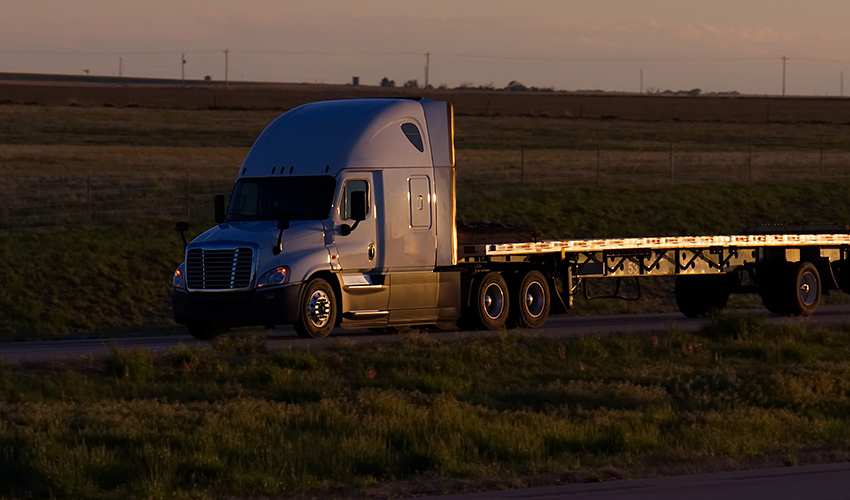Flatbed Truck and Trailer Guide: Dimensions, Restrictions, and More

What is a flatbed truck?
A flatbed truck is a large vehicle ideal for hauling oversized freight as it consists of a typical truck tractor, which houses the engine and cab, and a flat trailer with no sides or roof, the rear bed portion which carries flatbed freight.
Given the bed is not limited by the constraints of a traditional enclosed truck trailer, as with semi trucks, flatbeds can haul large pieces of equipment and other items that may be particularly tall or wide. They are also easier to load and unload with bed access from all sides.
Anyone looking to start a trucking company or get into short-haul trucking should familiarize themselves with the different types of flatbed trailers to find the best options for their enterprise. It’s also important to know flatbed-truck height restrictions as this will have direct implications for what can and cannot be hauled.
Types of flatbed trailers
Beyond the standard flatbed, which is entirely flat from front to back, there are varying types of flatbed trailers with distinct flatbed-trailer dimensions that make them unique. Below we will outline the most popular configurations, along with their benefits and limitations.
Step or drop deck trailer
A step deck trailer, also referred to as a “drop deck” trailer, is a common alternative to the traditional flatbed. It offers two bed sections of varying heights: an initial taller upper deck at the top steps down to a lower deck closer to the ground.
Step deck trailers allow for taller loads at their lowest point, making them extremely versatile. That extra bit of clearance can make a big difference while the height variations allow for more cargo options.
Extendable or stretch deck trailer
An extendable or “stretch” deck trailer is similar to the standard flatbed trailer but has a built-in sliding mechanism offering the ability to extend the length of the cargo bed. These are ideal for items that need more space lengthwise. Stretch decks are also available in a drop deck style.
In order to account for the added length, owners can attach a bulkhead to the front of the trailer to secure cargo and keep it from coming loose in the event of hard braking. Think of a bulkhead as a vertical partition, important for cargo control, adding an extra barrier and means for securement. Bulkheads can either be flat or have a short return on each side for even more support.
Lowboy or double drop trailer
Also known as a “double drop,” a lowboy trailer is just as it sounds. In order to sit as low to the ground as possible it utilizes two drops: one drop occurs immediately following the gooseneck (the long neck that hitches the trailer to the truck tractor) and another drop just before the rear trailer wheels.
The drops allow the trailer body to extend below the height of the wheels, maximizing overhead clearance. Lowboy trailers are ideal for hauling items that are extremely tall, as they allow for the most vertical clearance of any flatbed trailer design.
Removable gooseneck trailer (RGN)
An RGN is a unique flatbed design with a gooseneck that can be separated from the rest of the trailer. By removing the neck, the bed can be lowered and used as a ramp for easy loading. They are frequently used to haul oversized heavy machinery such as forklifts and bulldozers, which can be driven right up onto the truck bed for easy hauling.
Conestoga or curtainside trailer
This final flatbed trailer design is an interesting compromise between a standard walled tractor trailer and a flatbed. Curtainside trailers have a built-in sliding tarp mechanism that allows you to cover cargo and protect it from damage and the elements without solid walls. The tarps allow for accessibility on 3 sides when opened, while still providing a layer of protection for sensitive or delicate cargo.
Flatbed dimensions guide
Flatbed trailer dimensions vary depending on the type of trailer, manufacturer, and other factors. With that in mind, we will outline the most common dimensions, starting with standard flatbed trailer dimensions.
Standard flatbed
A standard flatbed trailer typically runs between 48 to 53 feet long, 8.5 feet wide, and 5 feet tall. With a standard 5-foot bed height, they can haul items up to 8.5 feet tall.
Step deck
Step deck trailer length runs between 48 to 53 feet long, with an 8.5 feet width. The upper deck follows a standard 5-foot height with a step down to a 3.6-foot-tall lower deck. The lower deck allows for loads up to 10 feet in height.
Extendable flatbed
Stretch flatbed trailers can extend up to 80 feet in length, with a standard 8.5 feet width and 5-foot height. That's quite a bit longer than a 53-foot flatbed, greatly extending capacity for extra-long items.
Lowboy
Common lowboy lengths run between 24 to 29 feet, 8.5 feet wide, with a well height (lowest point) of between 18 and 24 inches. Because they are so low, they have a legal freight height of up to 12 feet.
Curtainside
Curtainside trailers average 48 to 53 feet in length, an 8.5-foot width, 8-foot height, and a standard 5-foot bed height. They do not offer as much height clearance for cargo because of the overhead sliding tarp design.
Benefits of flatbed hauling
Flatbed trailers are beneficial for several reasons. Here are our Top 3.
1. Versatility
Flatbed trailers are extremely versatile. Not only are they easy to load, accessible by forklift from all sides, but they can handle, with the right configuration, just about any imaginable cargo.
2. Increased capacity
Flatbeds are specifically designed to hold a lot of weight with serious hauling capabilities. Increased hauling capabilities reduces the number of loads and trips for considerable cost savings.
3. Greater functionality
Lastly, flatbeds are available in many dimensions, allowing an operator to find the solution that best fits their specific needs. With so many types of flatbed trailers available, there is sure to be a right fit for any emerging enterprise.
Frequently asked flatbed trailer questions
How high can you load a flatbed?
The height of cargo that can be loaded onto a flatbed varies depending on the type of flatbed trailer and its bed height. Legally, in most states the overall height of the trailer and cargo must not exceed 13 feet 6 inches. Be sure to check state and local requirements.
How high is a flatbed trailer off the ground?
A typical flatbed trailer is 5 feet off the ground, although this can vary.
What can you haul on a flatbed?
The best part about flatbed trailers is the sky really is the limit in terms of hauling capabilities. From building materials and construction equipment to a full-blown spacecraft, if you can imagine it, it can likely be hauled with the right flatbed truck.
Flatbed hauling tips
As with any hauling business, it’s important that you arm yourself with the tools and equipment necessary for the best opportunity for success. Choosing the right flatbed trailer design is just one piece of the puzzle.
From proper load securement to fleet safety, there are many processes that go into a successful flatbed hauling business. Below are a few considerations that can help keep things rolling smoothly.
Fleet safety
When hauling heavy or oversize loads, it's important to ensure the safety of not only the driver but everyone else on the road. A comprehensive fleet safety solution using AI-powered dash cams can help ensure safe driving practices while protecting the integrity of the driver and enterprise should any events occur.
Fleet tracking
In addition to fleet safety, GPS fleet tracking is a great way to track vehicle movement and mileage, and to plan the most optimal routes given traffic, weather, and other road conditions.
DOT compliance
Lastly, when hauling large or oversize loads, it's important to maintain compliance. This applies to both maintaining legal load heights and weights as well as following hours of service regulations designed to keep everyone driving safely on our roadways. A FMCSA-compliant ELD solution is not only legally necessary for many commercial fleets, but takes a lot of the headache out of maintaining logs, easing administrative burdens.
Contact us or book a demo to learn more!

